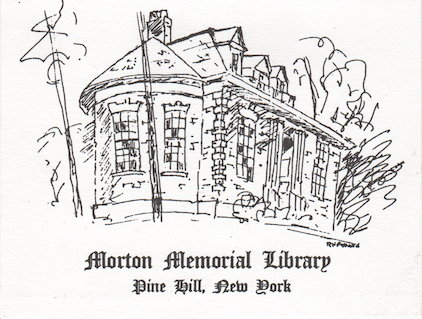
The hamlet of Pine Hill owes a great debt to Dr. Henry Morton. In the early 1900s, at his own expense he built stone roads, bridges, and sidewalks, planted hundreds of trees, and donated the land for the Pine Hill Cemetery. When his wife died, he built a beautiful library as a memorial to her – our own Morton Memorial Library.
Henry Morton was born in New York City on December 11, 1836. While an undergraduate at the University of Pennsylvania, a plaster cast of the Rosetta Stone was presented to the Philomathean Society of the University; no translation had been made yet, so Morton undertook the translation, which he completed during his senior year – an unparalleled achievement for an undergraduate student. Upon graduation he studied law, but it was his passion for the natural sciences that led him to his life’s work. The Episcopal Academy in Philadelphia, where his father was on the governing board, did not offer classes in the physical sciences, so Morton volunteered to give a series of lectures. They were so entertaining and well attended that a larger lecture hall was built to accommodate the audiences who wanted to hear him speak. Three years after he graduated from college, he was appointed to the professorship of chemistry at the Philadelphia Dental College, and five years later he accepted a professorship of chemistry at the University of Pennsylvania.
For four years (1864-1870), Morton was secretary of the Franklin Institute, where he gave a series of public lectures with great enthusiasm and showmanship at the Academy of Music, one of the largest auditoriums in the country, seating 3,500 people. To standing room audiences, he lectured on such tops as reflection, refraction, fluorescence, eclipses, and the combustion of iron in oxygen. The crowds were thrilled.
Two years later, at the age of 34, he became president of the Stevens Institute of Technology, a position he held until his death. While building the institute’s training program for electrical engineering, he continued his interest and work in pure science, publishing a notable series of papers on fluorescence. Two honorary doctorates were conferred on him, the second by Princeton University, in 1871. He was not simply the president of the Stevens Institute, an engineer, and an academic writer; he was a generous donor, a student of biblical criticism, an archeologist, an artist, and a lover of art and poetry, which he also wrote.
Morton and his wife, Clara, were long-time summer residents of Pine Hill and owned a home in Pine Hill that still stands on Birch Creek Road, over a stone bridge. He created the hamlet’s first library, purchasing a saloon that he refurbished and stocked with 500 volumes from his own personal library. When Clara died, he undertook the building of a grand new library building to replace the smaller one; construction of the new library was completed by his children, one year after Morton’s death, in 1903. Built in the Georgian Revival style, it stands out as the preeminent building in the hamlet due to its masonry construction, in contrast to the wood-frame buildings that make up the majority of the hamlet. The library building was listed on the National Register of Historic Places on February 21, 1997.
Contact webchanges@midhudson.org

